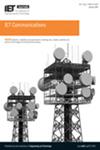Three‐dimensional geometry‐based channel modeling and simulations for reconfigurable intelligent surface‐assisted uav‐to‐ground MIMO communications
IF 1.5
4区 计算机科学
Q3 ENGINEERING, ELECTRICAL & ELECTRONIC
引用次数: 0
Abstract
Consisting of a large number of passive reflectors, reconfigurable intelligent surface (RIS) has gained traction as an approach to enhance communication quality. The specular reflection assumption is common when ideal conditions are considered. In this paper, an anomalous‐reflector model was found for each RIS reflection unit, deviating from the specular reflector assumption, and the impacts of the aperture area and radiation pattern of the RIS reflecting elements are taken into account. A three‐dimensional (3D) geometry‐based RIS‐assisted channel model is proposed for stochastic multiple‐input multiple‐output (MIMO) unmanned aerial vehicle (UAV)‐to‐ground communications. The RIS is deployed on an additional UAV in the proposed model, which assists the UAV transmitter for reflecting its own signals to the mobile receiver (MR) on the ground level, thereby boosting the quality of signal transmission. In order to achieve a perfect beam alignment towards the desired direction, the reflection phase is regulated by considering the propagation distances among UAV, RIS, and MR.基于三维几何的信道建模与仿真,用于可重构智能地表辅助飞行器对地多输入多输出通信
可重构智能表面(RIS)由大量无源反射器组成,作为一种提高通信质量的方法,它已获得广泛关注。在理想条件下,镜面反射假设很常见。本文偏离镜面反射假设,为每个 RIS 反射单元找到了异常反射模型,并考虑了 RIS 反射元件的孔径面积和辐射模式的影响。针对随机多输入多输出(MIMO)无人飞行器(UAV)-地面通信,提出了一种基于三维(3D)几何的 RIS 辅助信道模型。在所提出的模型中,RIS 被部署在额外的无人飞行器上,协助无人飞行器发射器将自身信号反射到地面上的移动接收器(MR),从而提高信号传输质量。为了使波束完美地对准所需的方向,需要考虑无人机、RIS 和 MR 之间的传播距离来调节反射相位。
本文章由计算机程序翻译,如有差异,请以英文原文为准。
求助全文
约1分钟内获得全文
求助全文
来源期刊

IET Communications
工程技术-工程:电子与电气
CiteScore
4.30
自引率
6.20%
发文量
220
审稿时长
5.9 months
期刊介绍:
IET Communications covers the fundamental and generic research for a better understanding of communication technologies to harness the signals for better performing communication systems using various wired and/or wireless media. This Journal is particularly interested in research papers reporting novel solutions to the dominating problems of noise, interference, timing and errors for reduction systems deficiencies such as wasting scarce resources such as spectra, energy and bandwidth.
Topics include, but are not limited to:
Coding and Communication Theory;
Modulation and Signal Design;
Wired, Wireless and Optical Communication;
Communication System
Special Issues. Current Call for Papers:
Cognitive and AI-enabled Wireless and Mobile - https://digital-library.theiet.org/files/IET_COM_CFP_CAWM.pdf
UAV-Enabled Mobile Edge Computing - https://digital-library.theiet.org/files/IET_COM_CFP_UAV.pdf
 求助内容:
求助内容: 应助结果提醒方式:
应助结果提醒方式:


